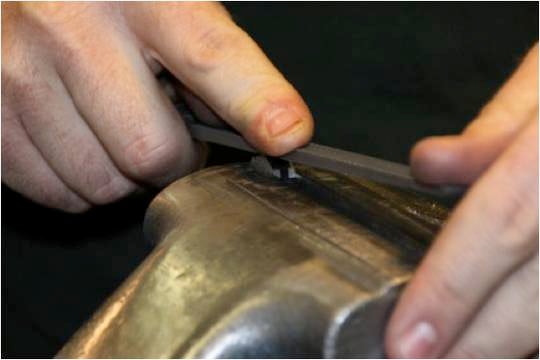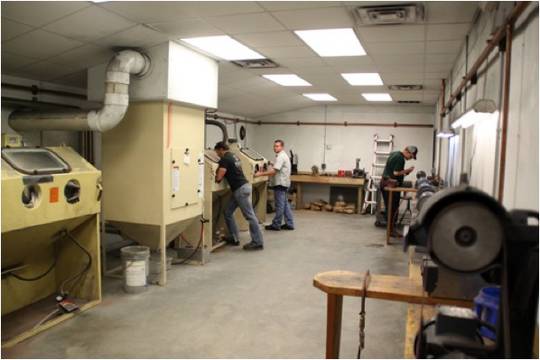[ This guest post was written by Brian Nelson. ]
The name Wilson Combat is no doubt familiar to the hordes of 1911-lovers (myself included) as the makers of the best custom 1911s around. I was lucky enough to be given a tour of their custom shop in Berryville, Arkansas. First I’d like to thank John May for showing me around, and all the guys at Wilson for letting some teenage blogger pester them with questions.
Warehouse
The heart of every manufacturing company is its warehouse. Wilson makes components and accessories not only for their own guns, but also for retail sale. The parts are kept separate and carefully organized.
Components
Everyone knows to build the best of anything, be it pies or pistols, you have to use the best components. Wilson not only makes some of the best components, but if they can’t make the best part they’ll outsource it to someone who can. For instance, an Oklahoma company that makes oil well parts also makes a darn good extractor; Wilson sells it as their “Bullet Proof” extractor.
Of course, Wilson does make the majority of parts themselves. Here are some of their QD sling mounts being made on a CNC. Wilson also uses the CNC to make most of their parts, including slides.
Build Process
Everything in a Wilson Combat 1911 is hand-fitted by experienced gunsmiths. Their process is separated into 3 operations with 3 different gunsmiths, “A-op”, “B-op” and Prep. Each gunsmith is given a bin of all the parts he’ll need to build either for a specific model or for a custom build. Typically the Wilson gunsmiths will finish around twelve 1911s in a day, but it varies depending on what model they’re building.
The “A-op” comes first. Here a gunsmith carefully fits the slide, barrel, and frame.
The “B-op” is next: Here another gunsmith fits all the small parts, does a trigger job and all the reliability work (ramping the barrel, fitting the extractor, etc.).
After “B-op”, the gun is essentially built. “Prep” is where the gun is prepared for finishing; all the sharp edges are dressed, the rear of the slide is contoured, and all the prep work for finishing is done.
A fourth operation, which I didn’t mention earlier, is called “Steve”. As Wilson Combat Sales Director John May told me “Every company needs to have a Steve hidden in the back. Every time he calls in sick, we find out another thing Steve does that we take for granted”. For instance, who puts the medallions in the grips?
One thing I noticed at the Wilson shop as opposed to other 1911 makers is that everything is done to the satisfaction of experienced (some 2nd generation) gunsmiths and shooters, not just to be CNC’ed within specifications. They separate the build process into three operations not just to streamline production (Wilson makes about 2500 1911s a year), but also to have not one, but three sets of eyes and hands check the work of the gunsmith before him. And that’s just what goes into their rack-grade guns.
Super Grade Guns
That’s right, that’s just a rack-grade gun. Wilson also offers a “Super Grade” line of 1911s, each built by a master pistolsmith to be the best 1911 you can buy. Everything is done by hand by some of the best gunsmiths in the industry. Oh, and good luck getting into one for less than $4000.00.
Engraving
Recently Wilson invested in a laser-engraving machine. That means they can etch their logo and whatever else they need onto a gun consistently and without risking the gun.
Test-Fire
After the guns are finished and engraved, they are all reassembled and test-fired. And speaking of test-firing, Wilson test fires at least 108 rounds with varied FMJ, Hollowpoint, and Lead Semi-Wadcutters. This is done to not only check for 100% reliability, but also to adjust any sights and ensure it’ll shoot a group smaller than a quarter. Just to compare, STI International, another leading 1911 maker, only puts one full magazine through any one of their guns, checking only for function. At the same time, STI makes a lot more guns in a year than Wilson.
Because Wilson test-fires their guns so much, year-round (and Arkansas winters can get pretty cold), they set up one heck of a test-fire range.
That’s just one of Wilson’s test-fire bays. They go out to 25, 50, and 100 yards (for rifles), and are separated by caliber. Why are they separated by caliber? Simple. See that chute coming down from the bench? That’s set up to collect brass when it hits the net separating the bays. Separating the bays by caliber makes it unnecessary to sort out all the brass (which they later reload into more test-fire ammo). Also, as I mentioned before, Wilson tests their guns so that they’ll shoot a group smaller than a quarter at 25 yards. What I didn’t mention is that they don’t use a Ransom Rest (you have to be a shooter to work for Wilson Combat!).
Not Just 1911s
Yes, Wilson Combat are the makers of primo 1911 handguns. But that’s not all they make, no-sir-ee. They also do Remington 870 shotguns and AR-15 rifles. They’ve also recently branched out into offering ammo and have been making good-looking knives since 2000.
**Scatterguns. Technically. **
In the year 2000, Wilson bought “Scatter Technologies” and they now make the best custom Remington 870s to be found, under the new name “Scattergun Technologies”. Their scatterguns are so good that they are relied upon every day by U.S. Border Patrol officers. And, as far as I can tell, they’re the only 870 makers who offer a 14’’ (NFA Item, Short Barreled Shotgun) barrel as a standard option (you can still get the non-SBS 18’’ barrel). They also offer aftermarket accessories for the 870.
Wilson also offers the “Remington Steal” package for a customer-supplied 870. Basically they take a beater 870 and make it “tactical”. This means replacing the furniture with new synthetic stocks, putting their proprietary “Trak-Lock” sights on, putting a +2 magazine tube on, and finally refinish the entire shotgun so it looks new and rugged. They’ll also convert a 2 ¾’’ gun into a 3’’ gun at no extra charge.
More ARs?
Yes, Wilson makes AR-15 rifles. Nothing too unique except that they offer them in some new and interesting calibers, like the .300 AAC BLK and their new proprietary 7.62x40WT round. Wilson also makes their own AR accessories, such as the TRIM quad-rail, drop-in trigger, and various lower receiver accessories. They also make titanium suppressors and a muzzle brake that doubles as a Quick-Detach mount for them.
Ammo
Recently Wilson branched out into the ammo-making business. Their stated goal is to produce “Accurate, Low Muzzle-Flash, Reliable Ammo”. Nowadays you’d be hard-pressed to find inaccurate, unreliable factory ammunition, but I haven’t seen any ammo that’s designed to be low muzzle-flash. It kind of makes sense for Concealed Carry, as it doesn’t do you any good to be blinded after your first shot, but it doesn’t make much difference for regular shooting.
Wilson recently came out with a new round, the 7.62x40mm Wilson Tactical. Basically it creates 7.62x39mm ballistics into an AR-15 style rifle. They make ammo offer brass and dies for the new round, and it takes common .308 caliber bullets. I’ll be writing another post about that soon. Another thing about Wilson ammo; It’s checked with a white glove. Ever round is gauged and examined by hand. Their “Dinged and Scratched” ammo rejects look better than my Match grade reloads.
Conclusion
I know the Wilson Combat shop impressed me, and I’ve seen high-end 1911s being built before. The quality components that go into a Wilson, combined with the amount of hand-fitting that is done to one, all combine to make a pricey ($2600.00+), high-end gun that is well worth the price.
 Your Privacy Choices
Your Privacy Choices























